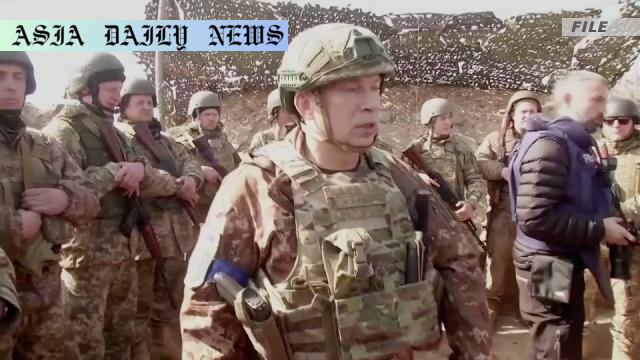Kursk: Ukrainian troops reposition for safety amidst continuous conflict, significant Russian losses reported in offensive.
Kursk conflict sees heavy fighting and Ukrainian troop repositioning.
Russia faces significant losses with over 90 tanks destroyed.
Ukraine vows extended defense amidst Russian and North Korean pressures.
City of Sudzha severely damaged by Russian airstrikes.

Ukrainian Troops Reposition in Kursk Amidst Escalating Conflict
The ongoing conflict in Kursk has reached a critical juncture as Ukrainian forces strategically reposition themselves amidst intensified Russian military incursions. According to Commander-in-Chief of the Ukrainian Armed Forces, Oleksandr Syrskyi, these movements are aimed at preserving the lives of troops while continuing to resist Russian advances. Moscow has deployed significant forces, including airborne assault units and special operation teams, in an attempt to overpower Ukraine’s defense and expel its troops from the region.
Syrskyi outlined the extent of Russian losses since Ukraine initiated cross-border attacks in August of the previous year. Over 54,000 soldiers have either been killed or injured, and nearly a thousand have been taken prisoner. The toll of the conflict is not just limited to manpower; over 90 Russian tanks and 654 armored combat vehicles have been destroyed. Despite these setbacks, Russia continues its campaign, seemingly driven by political motives rather than strategic military objectives.
Heavy Destruction and Civilian Impact in Kursk
Beyond the battlefield, the lives of civilians in areas like the city of Sudzha have been severely disrupted. Russian airstrikes have caused widespread destruction, with the city reportedly almost entirely destroyed. Despite these dire conditions, Ukraine’s military remains steadfast in its commitment to holding Kursk for as long as it takes.
The use of advanced Russian military assets, combined with reported support from North Korean troops, underlines the international dimensions of this conflict. Ukrainian forces, however, have displayed remarkable resilience, leveraging their defenses and improving tactical positioning to counter these challenges. The repositioning of troops to “more favorable positions” emphasizes a focus on strategic longevity while minimizing unnecessary loss of life.
The Political Calculations of the Kursk Conflict
The Kursk conflict represents more than just a military confrontation; it underscores the broader geopolitical struggle between Ukraine and Russia. Russia’s determination to invest heavily, even at the cost of significant losses, hints at a broader political agenda. Whether it is about showcasing dominance or diverting domestic discontent, the stakes are beyond territorial control.
Backed by substantial international support, Ukraine has managed to achieve tactical victories despite the odds. However, the destruction of civilian infrastructure and the ongoing humanitarian crisis reflect the prolonged suffering of those caught in the crossfire. As the world watches, Kursk remains a symbol of unwavering resistance against aggression.
In conclusion, the defense of Kursk stands as a testament to Ukraine’s resolve amidst a challenging military and political landscape. With significant Russian losses, growing international awareness, and unshaken commitment, Ukraine continues to push back, even facing unparalleled odds. The outcome of this battle might redefine the larger conflict between the two nations.
Commentary
The Kursk Conflict: Strategic Implications and Human Costs
The current developments in Kursk offer a stark reminder of the relentless nature of conflict and the human toll it takes. Ukraine’s strategic repositioning highlights the constant need for adaptation in warfare, but it also underlines the immense sacrifices made by troops on both sides. Protection of life remains paramount, yet the costs of this prolonged battle weigh heavily on all those involved.
Geopolitical Dimensions of the Struggle in Kursk
What makes the Kursk conflict particularly noteworthy is its geopolitical overtones. Russia’s sustained losses, far beyond what reasonable military objectives might dictate, hint at ulterior political motives. The apparent integration of North Korean armed forces into this conflict further complicates the situation, suggesting potential alliances that could have far-reaching consequences on global stability. Ukraine’s resolute defense draws international attention, serving as a rallying point for nations invested in resisting aggression.
The Cost to Civilians and the Path Ahead
Beyond the battlefield, the devastation of Sudzha and surrounding areas represents the profound human cost of this conflict. Entire communities face displacement, destruction, and loss—a fate that no political or military victory can ever justify. As we consider the future of Kursk and the larger Ukraine-Russia struggle, it is essential to emphasize diplomatic resolutions while recognizing the bravery of those defending their homeland.
In conclusion, the story of Kursk serves both as a grim reminder of the consequences of war and an illustration of resilience. While the path back to peace remains fraught with challenges, international solidarity and efforts towards resolution can eventually pave the way towards stability in the region.


